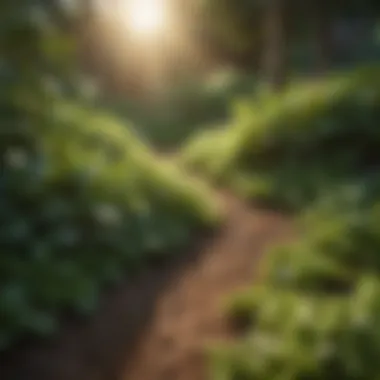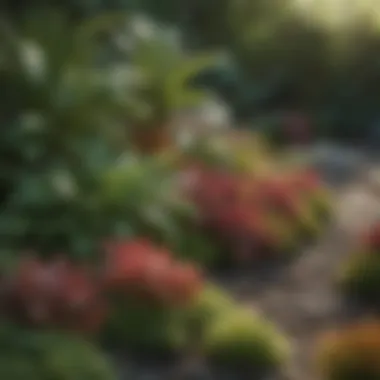Best Plants for Ground Cover in Full Sun Conditions


Intro
Ground cover plants serve as a vital aspect of landscape design, and selecting the right types for full sun conditions is crucial. They not only provide aesthetic appeal but also assist in preventing soil erosion and suppressing weeds. The versatility of ground cover options expands the potential for creative outdoor spaces that are both functional and attractive. This guide aims to explore various plants suitable for ground cover in sunny areas, highlighting their characteristics, benefits, and care requirements. Homeowners and gardening enthusiasts alike will find valuable insights to choose the best options for their outdoor environments.
Design Trends
When considering ground cover plants for full sun, several design trends emerge, reflecting current preferences in landscaping and gardening.
Current Popular Styles
The trend in landscaping has shifted towards low-maintenance gardens. Ground covers that require minimal upkeep are favored by homeowners who prefer a more naturalistic look. Choices such as Creeping Thyme and Sedum species are growing in popularity due to their resilience and colorful blooms. Incorporating a mix of textures and height variations enhances these designs.
Color Palettes for Modern Spaces
Color choices play an important role in selection. To match modern trends, consider using ground covers that feature vibrant blooms alongside rich green foliage. For example, Vinca Minor displays hardy, glossy leaves with periwinkle-blue flowers that create a serene, sophisticated look. Similarly, Ajuga Reptans, or Bugleweed, offers deep blue spikes among its distinctive foliage, adding depth and contrast to any landscape.
Benefits of Using Ground Cover
Utilizing ground cover plants in full sun has various benefits:
- Soil Protection: They help maintain soil integrity by reducing erosion.
- Weed Suppression: Establishing a dense cover discourages weed growth, reducing the need for herbicides.
- Biodiversity: Different plants attract various pollinators, contributing to garden health.
Ground cover plants also enhance curb appeal and support a sustainable gardening approach, allowing eco-conscious designs.
Maintenance Considerations
Caring for ground cover plants in sunny areas requires some thoughtful planning. Choose varieties that align with your local climate and soil conditions.
- Watering Needs: Most sunny ground covers are drought-resistant, but newly planted ones may require regular watering until established.
- Pruning: Routine pruning can help maintain shape and promote growth, especially in aggressive species.
- Fertilization: A balanced approach to fertilizing ensures plants remain healthy without overstimulating growth, which may lead to overcrowding.
Effective ground cover selection can significantly impact your landscape's overall aesthetics and functionality.
Closure
Preface to Ground Cover Plants
Ground cover plants are an essential component of landscape design. They offer various functions such as enhancing aesthetic value, preventing soil erosion, and suppressing weed growth. In full sun environments, the selection of appropriate species becomes crucial. When plants receive ample sunlight, they can thrive and provide optimal ground coverage, minimizing areas prone to weeds or bare soil.
Ground cover plants also help with moisture retention. Their foliage can shade the soil, reducing evaporation and maintaining consistent soil temperatures. This characteristic is especially significant in regions with high temperatures, making the right selection of ground cover beneficial for healthy landscapes.
Another benefit of these plants is biodiversity. By integrating a variety of ground cover options, gardeners can create habitats that encourage local wildlife, including pollinators like bees and butterflies. This aspect contributes to the ecological balance of the area while offering visual interest.
With that in mind, understanding the types of ground cover plants suitable for sunny settings allows homeowners and gardening enthusiasts to create inviting outdoor spaces that are easy to maintain and visually stunning. Therefore, this guide will explore the nuances of ground cover plants and their specific requirements in full sun conditions.
Understanding Ground Cover
Ground cover refers to low-growing plants that spread across the earth’s surface, forming a protective layer. These plants can range in type, including grasses, perennials, and even shrubs. The primary purpose is to cover the ground, acting as a living mulch to shield against weeds and soil erosion.
Ground cover plants have different growth habits. Some spread horizontally while others may grow vertically. The choice of plant depends on the desired aesthetics and functional requirements of the space.
In addition to their practical usage, ground covers can enhance the visual appeal of a landscape. By selecting various leaf colors and textures, it is possible to create striking designs.
Importance of Full Sun Conditions
Full sun conditions typically mean that a plant will receive at least six hours of direct sunlight each day. Many plants thrive under these conditions, growing more vigorously and displaying brighter colors.
Planting in full sun allows for the selection of species that are drought-resistant. These plants can efficiently utilize the sunlight to photosynthesize, leading to faster growth and denser coverage. This characteristic is beneficial for those looking to fill bare patches quickly.
Plants that do well in full sun often have features such as drought tolerance and resilience to varying soil types. They usually develop deeper root systems, helping them gather water more effectively. This trait is particularly useful in areas with fluctuating rainfall patterns, making them a wise choice for sustainability.
Characteristics of Ideal Ground Cover Plants
Understanding the essential characteristics of ground cover plants is crucial for achieving effective landscaping in full sun conditions. These plants not only enhance the aesthetic appeal of outdoor spaces but also serve practical functions. Selecting the right ground cover can improve soil quality, reduce weed growth, and retain moisture. In this section, we will delve into three key attributes that define ideal ground cover plants: drought resistance, growth habit, and soil adaptability.


Drought Resistance
Drought resistance is a fundamental characteristic of ground cover plants, particularly in areas that experience hot and dry summers. Plants that are resilient to drought typically have adaptations such as deep root systems, xerophytic features, and a reduced leaf area to minimize water loss. By selecting drought-resistant ground cover, homeowners can sustain landscape vitality while conserving water resources. These plants thrive in conditions where rainfall is scarce, making them well-suited for full sun areas.
Examples of drought-resistant plants include Creeping Thyme and Sedum, both known for their ability to flourish in dry soil. This resistance not only contributes to lower maintenance requirements but also enhances the ecological balance by supporting local wildlife, such as pollinators. In regions facing water scarcity, incorporating these plants in landscaping is both a practical and environmentally friendly choice.
Growth Habit and Coverage Speed
The growth habit and coverage speed of ground cover plants are critical for ensuring rapid and effective coverage of bare soil. Ideally, these plants should spread quickly to create a dense mat, thereby suppressing weeds and minimizing erosion. Homeowners often prefer ground covers that establish themselves within a short period, allowing for immediate visual impact.
Plants like Ajuga and Moss Phlox exhibit lush growth habits and can cover large areas relatively fast. This makes them ideal for filling in spaces between other plants or hardscapes. Additionally, many ground covers can tolerate foot traffic, which is beneficial for pathways or areas near patios. A well-chosen ground cover can transform a barren landscape into a vibrant and engaging environment.
Soil Adaptability
Soil adaptability is another vital feature of effective ground cover plants. Choosing plants that can thrive in various soil types and conditions increases the chances of creating a lush landscape. Ideal ground covers should be able to tolerate diverse environments, whether it's sandy, clay-based, or loamy soils.
For instance, Lamb's Ear can grow well in poor soil and still provide attractive foliage. On the other hand, Sedum varieties are known for their ability to thrive in rocky or well-drained soil. Understanding the soil conditions of your garden is essential when selecting a ground cover. By matching plant preferences to the existing soil type, homeowners can enhance plant health and ensure a successful landscape.
Popular Plants for Full Sun Ground Cover
Ground cover plants are a fundamental aspect of landscape design. When it comes to full sun, specific plants excel in thriving under these conditions. Understanding these plants involves recognizing their unique benefits, such as weed suppression, moisture retention, and aesthetics.
The selection of popular plants for this application allows homeowners to create vibrant, low-maintenance landscapes. These plants often require less water and maintenance once established. Moreover, they contribute significantly to minimizing soil erosion and enhancing biodiversity, promoting a healthier environment.
Creeping Thyme
Description and Benefits
Creeping thyme is a hardy perennial that performs well in full sun. It features small leaves and produces pink or purple flowers in summer. This plant is beneficial because it can tolerate dry conditions, making it an effective ground cover in sunny areas. Its dense mat-like growth habit provides great weed suppression. In addition, it exudes a pleasant fragrance when stepped on, providing an enjoyable sensory experience within your garden.
Creeping thyme is also valued for its drought resistance and ability to attract pollinators, such as bees. However, its susceptibility to overwatering in poor-draining soil can be a drawback.
Maintenance Needs
Creeping thyme requires minimal maintenance, making it an efficient choice for ground cover. Regular trimming after flowering helps maintain its shape and encourages fuller growth. While it needs well-drained soil, overwatering should be avoided. This allows the plant to flourish without the risk of root rot or other moisture-related issues.
When planted in a low-traffic area, it thrives well; however, heavy foot traffic can cause damage, so consider the arrangement accordingly.
Sedum
Varieties Suitable for Ground Cover
Sedum, commonly referred to as stonecrop, consists of many varieties that suit ground cover needs in sunny areas. Some popular choices include Sedum spurium, also known as two-row stonecrop, and Sedum album, or white stonecrop.
These varieties are celebrated for their ability to withstand drought and poor soil conditions. Their fleshy leaves store water, providing a unique advantage in maintaining a vibrant look, even during dry spells. As ground cover, Sedum offers lush greenery and colorful flowers, enhancing the visual appeal of the landscape.
Certain varieties may spread rapidly, creating a thick mat of foliage that outcompetes weeds. However, some can become invasive if not monitored.
Site Preferences
Sedum plants prefer well-draining soil and should be placed in areas with plenty of sun. They work well in rock gardens, between pavers, or as edging plants along walkways. Due to their drought resistance, they require less watering once established, reinforcing their appeal for low-maintenance gardens.
Their fast growth highlights versatility in various designs but requires careful monitoring to prevent domination of neighboring plants.
Ajuga (Bugleweed)
Color Variations
Ajuga, or bugleweed, comes in a range of colors and leaf variations, including deep green, purple, and variegated types. This diversity enhances its appeal, making it suitable for ground cover in sunny settings. The vibrant foliage adds visual contrast against more traditional green plants.
Ajuga flowers typically appear in spikes and can bring additional color during spring. Its ability to thrive in full sun makes this plant especially valuable for dynamic landscaping.
The only downside is that it can spread aggressively, so careful management is necessary to ensure it does not encroach on other garden features.


Spread and Growth Tips
Ajuga spreads through underground runners, allowing it to cover ground quickly. When planting, space them properly to avoid overcrowding, which can lead to reduced airflow and increased disease risk. Regular maintenance, including occasional division, helps to maintain healthy growth.
Best results occur when planted in moist, well-drained soil, keeping its foliage lush and vibrant. Ajuga may struggle in hot, dry conditions without adequate moisture, so ensure consistent watering during prolonged dry periods.
Moss Phlox
Flowering Characteristics
Moss phlox, or Phlox subulata, is a popular ground cover plant noted for its stunning spring flowers that bloom in shades of blue, pink, and white. The flowers provide a striking carpet of color during early spring, offering great aesthetic appeal in full sun gardens.
Beyond beauty, moss phlox is also resistant to deer, making it a practical choice for many homeowners. However, the flowering period is relatively short, and gardeners should plan complementary plants to ensure year-round interest.
Use in Landscape Design
Moss phlox can serve various functions in landscape design. Whether as a border plant, sloping ground cover, or in rock gardens, its adaptability helps create stunning visual displays. Combining it with other plants that bloom at different times can prolong the color contrast in your landscape.
Consider placing moss phlox near pathways or patios for the best visual impact and enjoy their fragrance close-up.
Lamb's Ear
Texture and Feel
Lamb's ear, or Stachys byzantina, is recognized for its soft, velvety leaves that add an interesting texture to gardens. This perennial thrives in sunny conditions, providing gray-green foliage that contrasts beautifully with bright flowers and grasses. Its unique texture invites touch, creating a sensory experience in your outdoor space.
Lamb's ear does well in various soil types, as long as they drain well, and it is also drought tolerant once established. However, it may struggle in excessively humid conditions.
Companion Planting
When using lamb's ear in gardens, consider companion planting with other drought-resistant species like rosemary or sedum. Its foliage doesn't compete aggressively for resources, which allows neighboring plants to thrive.
In addition, lamb's ear tends to attract beneficial insects while repelling some pests, creating a more balanced ecosystem in your garden. However, be cautious, as it can spread and become invasive in certain conditions.
Factors to Consider When Selecting Ground Cover Plants
Climate Suitability
Climate is a primary consideration in selecting ground cover plants. Different plants have varying tolerance levels to temperature extremes, rainfall, and humidity. Regions with hot summers and cold winters will necessitate different plant choices compared to areas with temperate climates.
For instance, plants like Creeping Thyme flourish in warmer climates and can resist drought, while others might do better in environments with high moisture levels. Researching local climate conditions will enable you to effectively choose ground cover plants that can not only survive but thrive. Plants that adapt well to local climate are typically easier to maintain and more resilient to pests and diseases.
Surface Conditions
Surface conditions encompass several critical aspects, including sunlight exposure and soil type. These elements directly affect how well ground cover plants will establish and spread.
Sunlight Exposure
Sunlight exposure is vital for plant health. Most ground cover plants thrive in full sun, which is generally defined as at least six hours of direct sunlight daily. Full sun conditions help promote vigorous growth, vibrant colors, and prolific flowering.
A key characteristic of good sunlight exposure is the interaction between the sun and the leaf surface. For example, plants like Sedum benefit from maximum sunlight, as they have evolved to utilize it for efficient photosynthesis. The unique feature of having adequate sunlight is that it can significantly reduce the chances of disease by promoting airflow around the foliage, thus minimizing moisture retention.
However, care must be taken to ensure that plants are not exposed to harsh, unfiltered sunlight all day.
"Understanding sunlight exposure aids in making informed choices about ground cover plants that align with landscape design goals."
Soil Type
Soil type plays a crucial role in grounding cover plant selection. Factors such as drainage, texture, and nutrient content can greatly influence plant growth. For instance, sandy soils drain quickly and are less likely to retain moisture, favoring drought-tolerant species like Lamb's Ear.
In contrast, clay soils can hold excess moisture, which may lead to root rot for plants that prefer dry conditions. Identifying the soil type in your area will help in choosing plants that will suit those conditions well.
A unique characteristic of soil type is its capacity to support varying plant root systems. Plants that thrive in nutrient-rich soil can lead to robust growth and extensive coverage.


Choosing ground cover plants based on soil type ensures that each plant occupies its ideal environment, leading to a healthier garden overall.
By carefully considering climate and surface conditions, you can successfully select the most suitable ground cover plants for full sun locations, ensuring a thriving and sustainable landscape design.
Sustainable Practices in Ground Cover Planting
Sustainable practices in ground cover planting focus on creating a healthy ecosystem while minimizing resource use. By choosing the right plants and employing efficient techniques, homeowners can improve their landscapes and contribute to environmental conservation. These practices result in lower water usage, reduced need for chemical inputs, and improved biodiversity. They also promote a habitat for various beneficial organisms, helping to create a balanced environment.
Native Plant Selection
Selecting native plants is a fundamental aspect of sustainable ground cover practices. Native species have evolved to thrive in specific local conditions, making them more resilient to pests and diseases. They require less maintenance compared to non-native plants. For instance, choosing local varieties of creeping thyme or sedum benefits the ecosystem as these plants attract native pollinators, enhancing biodiversity. Additionally, they often have lower water requirements, contributing to water conservation. Some advantages of native plant selection include:
- Lower maintenance costs: Native plants typically require fewer resources.
- Enhanced ecological balance: Native species support local wildlife, leading to a more stable habitat.
- Soil health improvement: Their deep-root systems can enhance soil structure and prevent erosion.
Water Conservation Techniques
Implementing water conservation techniques is vital in minimizing the environmental footprint of ground cover planting. Efficient irrigation methods can dramatically reduce water usage. For instance, drip irrigation systems direct water to the roots more effectively compared to traditional sprinklers. An additional strategy is using mulch; it retains moisture in the soil and suppresses weed growth. This can decrease the frequency of irrigation required during dry seasons. Other water conservation techniques include:
- Rainwater harvesting: Collecting runoff can provide a free water source.
- Soil moisture monitoring: Understanding when plants need water can prevent overwatering.
- Plant groupings: Arranging plants with similar water needs minimizes waste.
"The mindfulness placed in choosing native species and efficient watering techniques plays a revolutionary role in sustainable landscaping."
By adopting these sustainable practices, homeowners can cultivate stunning landscapes that also honor ecological integrity. Engaging thoughtfully with nature not only beautifies outdoor spaces but also fosters a healthier environment.
Maintenance and Growth Strategies
Maintenance and growth strategies are crucial for ensuring that ground cover plants thrive in full sun conditions. Proper maintenance not only enhances the aesthetic appeal of your landscape but also contributes to the health and longevity of the plants. A well-maintained ground cover can effectively suppress weeds, retain moisture, and provide a vibrant palette throughout the seasons. This section will detail the essential maintenance practices required for optimal growth and coverage.
Weed Management
Weeds can be a significant challenge in maintaining ground cover in sunny areas. They compete for resources such as sunlight, water, and nutrients, which can hinder the growth of your chosen plants. Effective weed management strategies can help keep these unwanted plants at bay. Here are a few methods to consider:
- Mulching: Applying a layer of mulch around your ground cover plants creates a barrier that suppresses weed growth. Organic mulches also enrich the soil as they decompose.
- Regular Monitoring: Inspect your ground cover regularly to catch weeds early. Pulling them up by hand or using a hoe can prevent them from establishing roots.
- Herbicides: If necessary, selective herbicides can be used, but it is important to follow the manufacturer’s guidelines to prevent damage to your ground cover plants.
Implementing these strategies will reduce weed pressure and enhance the overall health of your ground cover.
Fertilization Requirements
Proper fertilization is vital to ensuring that ground cover plants receive the nutrients they need for robust growth. In full sun, the nutrient demands can be higher due to rapid growth rates. Here are some key considerations for fertilization:
- Soil Testing: Before applying fertilizer, test your soil to determine its nutrient content. This can help you apply the right type and amount of fertilizer needed.
- Choosing the Right Fertilizer: Look for a balanced fertilizer that includes nitrogen, phosphorus, and potassium. Slow-release fertilizers are preferred as they provide a steady supply of nutrients over time.
- Timing: Fertilize in early spring just before the growing season. This timing helps plants absorb nutrients when they are actively growing.
- Application Method: Follow the application rates provided on the fertilizer packaging. Over-fertilizing can harm plants and lead to excessive growth, making maintenance more difficult.
By following these guidelines, you can ensure that your ground cover plants in full sun flourish.
Pruning and Trimming Practices
Pruning and trimming ground cover plants are essential practices that promote healthy growth and prevent overcrowding. These practices not only keep the plants neat but also encourage thick, lush coverage. Important tips include:
- Timing of Pruning: The best time to prune is in the early spring or after flowering, depending on the specific plant type. This helps shape the plants and allows for new growth.
- Tools Needed: Use sharp and clean pruning shears to minimize damage to the plants. Hand pruners work well for small areas while hedge trimmers can cover larger sections efficiently.
- Cutting Techniques: Focus on cutting back older, woody stems and removing any dead or damaged growth. This stimulates new growth and enhances plant vigor.
- Assessing Growth Habits: Understand the growth habits of your chosen plants. Some may require more aggressive pruning than others. Researching each plant type helps in deciding how often and how much to prune.
The right approach to pruning and trimming ensures that your ground cover remains healthy and well-structured, ultimately enhancing its visual impact in your landscape.
Conclusion: Successful maintenance and growth strategies for ground cover plants in full sun are integral to a thriving garden. By implementing effective weed management, appropriate fertilization, and prudent pruning practices, one can create a vibrant and sustainable ground cover that enhances outdoor spaces.
The End
The topic of ground cover plants in full sun is significant due to its practical implications for homeowners and garden enthusiasts. Understanding the essence of choosing the right plants for these conditions not only enhances the overall aesthetics of outdoor spaces but also contributes to sustainable gardening practices.
Summarizing Key Points
In this article, we covered various aspects concerning ground cover plants suitable for full sun. Key points include:
- Understanding ground cover: The role of ground cover in landscape design provides benefits such as erosion control and weed suppression.
- Characteristics of ideal plants: Plants must exhibit drought resistance, quick growth, and adaptability to different soil types.
- Popular plant choices: Varieties like Creeping Thyme, Sedum, and Lamb's Ear offer unique benefits while thriving in sunny conditions.
- Selection factors: Evaluating climate suitability and surface conditions is crucial for the successful establishment of ground covers.
- Sustainable practices: Choosing native plants and employing water conservation techniques lead to healthier ecosystems.
- Maintenance strategies: Effective weed management, proper fertilization, and routine pruning align with the care of these plants.
Future Trends in Ground Cover Planting
Looking ahead, several trends are emerging in the field of ground cover planting. Gardeners are increasingly embracing:
- Diversity in plant selection: More people are exploring a wider variety of species to create unique, vibrant landscapes.
- Technological integration: Advances in gardening tools and strategies facilitate easier maintenance and monitoring of plant health.
- Eco-friendly practices: An emphasis on sustainability is steering selection towards plants that require less water and maintenance, promoting biodiversity.
- Edible ground covers: Interest in edible landscaping has surged, leading to choices like edible clovers or creeping herbs.
- Community involvement: Gardeners are increasingly collaborating in local projects, sharing knowledge, and creating communal green spaces.
The integration of these elements will not only aid in achieving aesthetically pleasing landscapes but also promote environmentally friendly gardening practices. As trends evolve, keeping informed will remain essential for making educated selections in ground cover planting.















